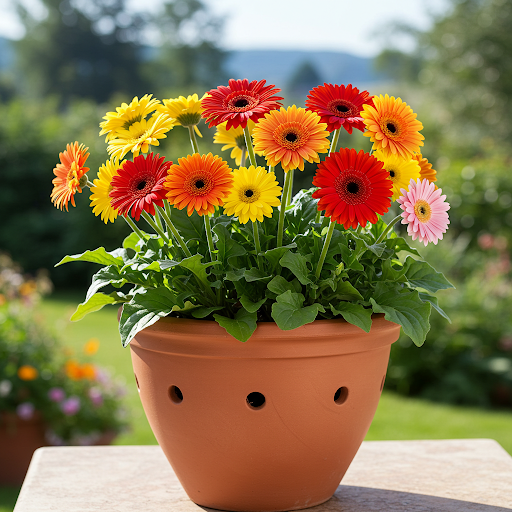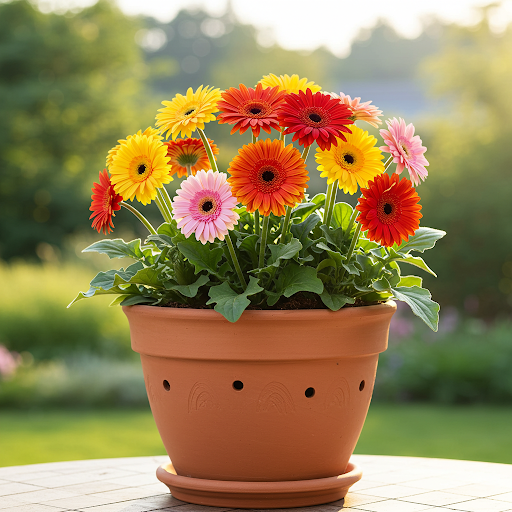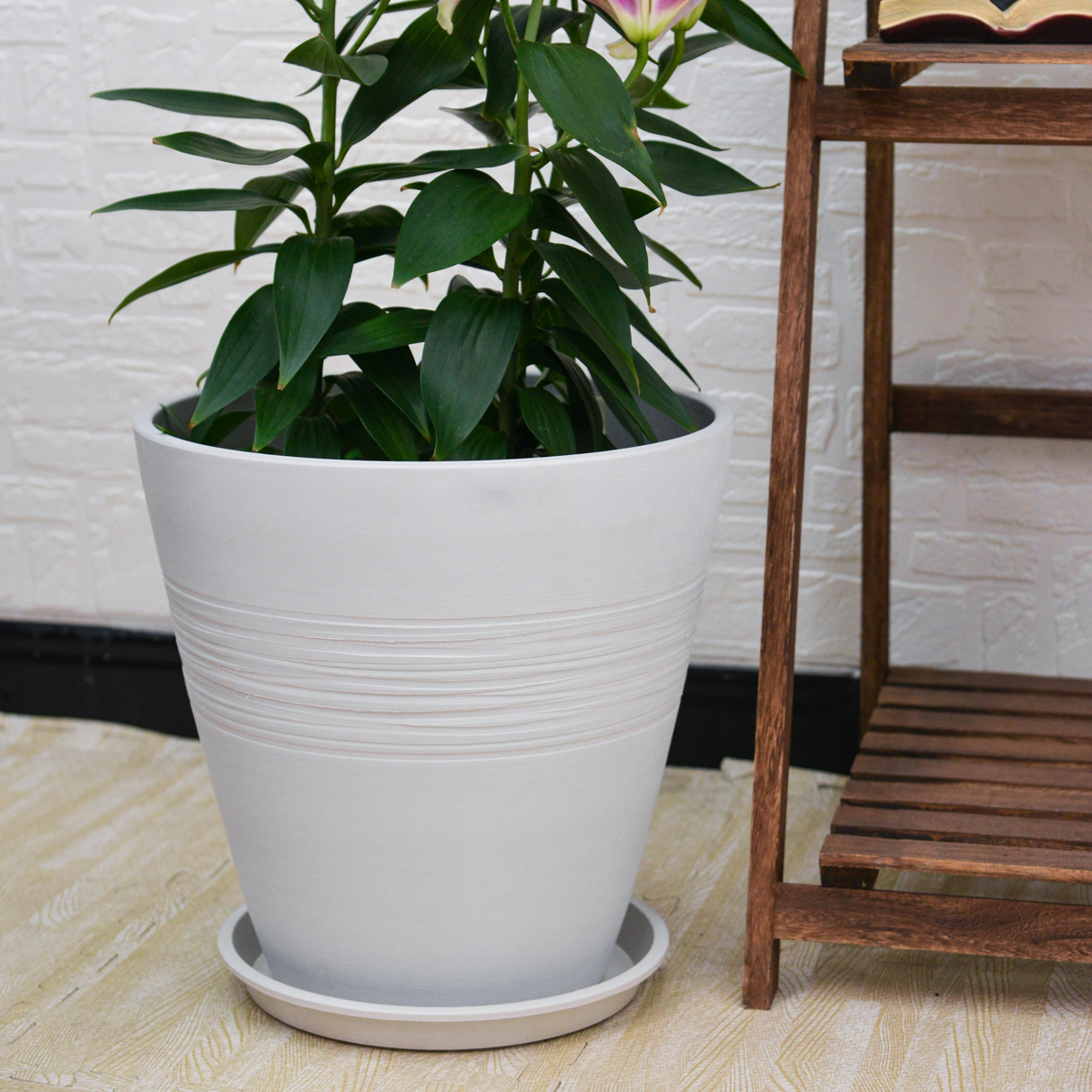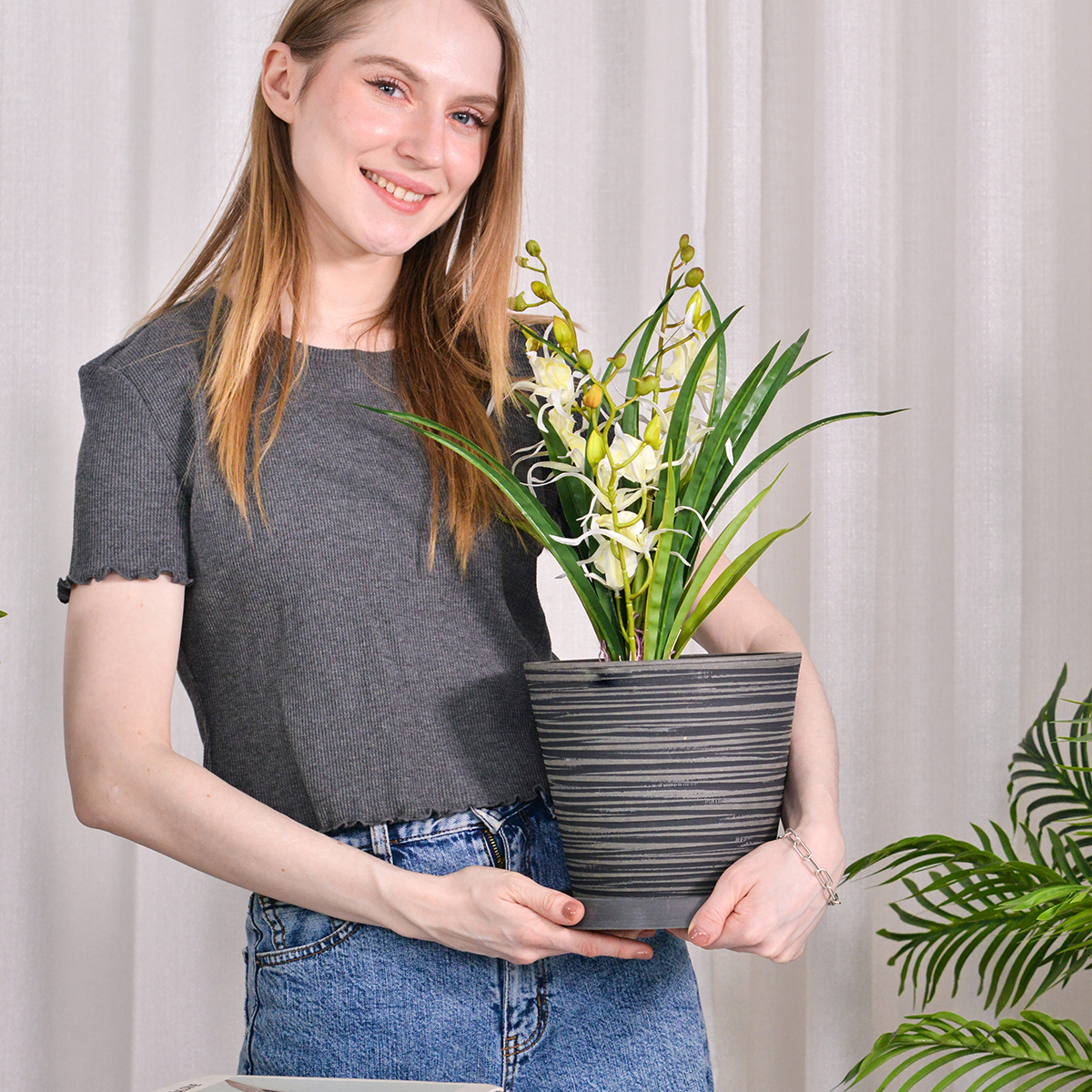Gerbera Daisies in Pots: The Ultimate Guide to Growing Vibrant Gerberas Outdoors
Want to infuse your patio, balcony, or garden with bold, cheerful, daisy-like blooms? Gerbera Daisies, renowned for their large, vibrant flowers in a rainbow of colors, are a fantastic and rewarding choice for outdoor container gardening. Celebrated for their striking, daisy-form flowers in incredibly diverse and bright hues, and their ability to bring long-lasting color, Gerbera Daisies are perfect for adding low-maintenance joy to sunny outdoor spaces. This comprehensive guide will provide you with everything you need to know to grow Gerbera Daisies successfully in outdoor pots, from selecting the best varieties and containers to mastering essential care techniques for a season filled with Gerbera brilliance.

Gerbera Daisies
What are Gerbera Daisies?
Gerbera Daisies, also simply known as Gerberas, are a genus of flowering plants in the Asteraceae family (daisy family). Native to South Africa, Asia, and South America, Gerberas are popular tender perennials typically grown as annuals in most climates, prized for their large, showy, daisy-like flowerheads and long-lasting blooms. Gerbera flowers are famous for their intense, vibrant colors, including red, pink, orange, yellow, white, cream, and bi-colors, and their classic daisy form with a prominent central disk and ray florets (petals). They come in various flower forms, including single, semi-double, and double petals, and different petal shapes, from classic daisy to crested and quilled forms. Gerbera plants are typically low-growing, clumping, or mounding, ranging in height from 6 to 18 inches tall, depending on the variety. They are known for their long blooming season (spring to fall), dazzling colors, classic daisy shape, and attractiveness as cut flowers, making them a beloved choice for gardens and containers, especially for adding cheerful, long-lasting color.
Are Gerbera Daisies Good for Outdoor Pots?
Yes, Gerbera Daisies are exceptionally well-suited for outdoor pots and container gardening. Their long blooming season, compact growth habits, wide array of vibrant colors, and desire for well-drained conditions make them ideal for filling pots, window boxes, and mixed container arrangements with dazzling, daisy-like blooms. Gerbera Daisies thrive in sunny locations and bloom profusely throughout the warm season, providing a long-lasting and cheerful floral display in containers. Their relatively easy care and striking floral displays make them a fantastic and rewarding choice for container gardens of all styles, especially for adding a touch of classic, cottage, or contemporary flair to patios, balconies, and decks.
Ideal Growing Conditions for Gerbera Daisies in Pots:
Types of Gerbera Daisies for Pots: Many Gerbera Daisy varieties are excellent for pots, but consider your desired flower size, color, and plant habit when choosing:
- Dwarf Gerbera Daisies: (e.g., ‘Festival Series’, ‘ বেঙ্গল Series’, ‘ Patio Series’) – Compact and smaller in stature, typically 6-10 inches tall, bred specifically for containers and smaller spaces. Ideal for small to medium pots, window boxes, and mixed containers. Known for their neat, compact habit and profusion of smaller to medium-sized flowers. Excellent for creating dense, colorful displays in pots and for the front of mixed arrangements.
- Standard Gerbera Daisies: (e.g., ‘Jamesonii Hybrids’, ‘Garvinea Series’, ‘ Revolution Series’) – Classic Gerbera types, typically 12-18 inches tall, with larger flowers (4-5 inches in diameter). Suitable for medium to large pots as focal points or in mixed containers. Offer impressive flower size and a wide range of colors and flower forms.
- Spider Gerbera Daisies: (e.g., ‘Spider Series’, ‘F1 Spider’) – Unique flower form with long, spidery, quill-like petals, adding textural interest. Available in various colors. Good for adding unique forms and textures to container displays. May be slightly taller than standard types.
- Pastel and Novelty Colors: (e.g., ‘Pastel Shades Mix’, ‘ Terra Cotta’, ‘ Green Goddess’) – Beyond the bright classic colors, explore varieties in softer pastel shades (pale pink, cream, peach) or novelty colors (green, muted tones) for different aesthetic effects.
Light: Gerbera Daisies thrive in bright, sunny locations. They need at least 6 hours of direct sunlight per day, and ideally more, to bloom profusely and maintain vibrant colors. Choose a sunny location for your Gerbera containers, such as a south-facing patio, balcony, or garden bed. While they love sun, in very hot summer climates, especially in the afternoon, providing some afternoon shade can be beneficial to prevent scorching of flowers and foliage, particularly in hotter regions. Morning sun is ideal, with some protection from intense afternoon heat. In shady locations, Gerbera Daisies will produce fewer blooms and may be more susceptible to diseases.
Soil: Gerbera Daisies need well-draining, airy soil that is rich in organic matter. Use a high-quality potting mixspecifically formulated for containers or flowers. Amend potting mix with perlite, vermiculite, or coco coir to improve drainage and aeration. Incorporate compost or well-rotted manure into the potting mix to enrich it with organic matter and improve drainage further. Avoid heavy, compacted soil or garden soil in pots, as they can become waterlogged and lead to root rot. A slightly acidic to neutral pH (around 5.5-6.5) is ideal for Gerbera Daisies. Excellent drainage and aeration are crucial to prevent root rot, which is a common problem with Gerberas.
Watering: Gerbera Daisies prefer consistently moist soil, but dislike soggy conditions. Water thoroughly when the top inch of soil feels slightly dry. Water deeply until water drains out of the drainage holes. Allow the soil surface to dry slightly between waterings, but do not let the soil dry out completely, especially when plants are actively growing and blooming. Avoid overwatering and constantly wet soil, which can lead to root rot. Water frequency will depend on weather conditions, light levels, pot size, and plant size. During hot, sunny, or windy weather, you may need to water more frequently. Check soil moisture regularly and adjust watering accordingly. Water at the base of the plant to keep foliage and flowers dry and help prevent fungal diseases. Morning watering is generally best.
Temperature: Gerbera Daisies are warm-weather plants that thrive in moderate temperatures. They perform best in temperatures between 70°F to 75°F (21°C to 24°C). They are sensitive to frost and freezing temperatures and are typically grown as annuals in areas with frost. Gerbera Daisies prefer warm days and cool nights for optimal blooming. They can tolerate heat, but prolonged high temperatures above 90°F (32°C), especially combined with high humidity, can stress plants and reduce flowering. Providing some afternoon shade in very hot summer climates can be beneficial. They are not cold-hardy and will be damaged or killed by frost. If you live in a frost-free zone (USDA zones 9-11), some Gerbera varieties may be grown as tender perennials, but in most climates, they are treated as annuals and replanted each year.
Fertilizer: Gerbera Daisies are moderate feeders and benefit from regular fertilization, especially when grown in pots where nutrients can leach out more quickly. Fertilize every 2-4 weeks during the blooming season to encourage continuous flowering. Use a balanced liquid fertilizer (e.g., 10-10-10 or 20-20-20) diluted to half strength, or a fertilizer specifically formulated for flowering annuals. Alternatively, you can use a slow-release fertilizer incorporated into the potting mix at planting time, supplemented with liquid feed later in the season if needed. Avoid over-fertilizing, especially with high-nitrogen fertilizers, which can promote leafy growth at the expense of blooms. A fertilizer slightly higher in phosphorus can encourage more abundant flowering.
Choosing the Right Pots for Gerbera Daisies:
Suitable Pot Types: Gerbera Daisies are adaptable to various pot types, including terracotta, ceramic, plastic, resin, and window boxes. Consider these factors when selecting pot types for Gerberas:
- Terracotta Pots: Porous, allow good aeration and drainage, and aesthetically classic. Terracotta is a good choice for Gerbera Daisies as it helps prevent overwatering and promotes good root health. However, terracotta pots also dry out more quickly, so monitor soil moisture, especially in hot weather.
- Ceramic Pots: Available in many decorative styles, can add a decorative element to your container garden, and retain moisture reasonably well. Ensure good drainage. Glazed ceramic pots retain moisture better than unglazed terracotta. Choose based on your desired aesthetic and moisture retention needs.
- Plastic Pots: Lightweight, inexpensive, retain moisture well, and are available in various colors and styles. Excellent choice for Gerbera Daisies, especially for moisture retention and for larger pots that need to be moved. Choose good quality plastic pots with drainage holes. Lighter colored plastic pots may heat up less in direct sun.
- Resin Pots: Lightweight, durable, available in various styles mimicking terracotta or ceramic, and offer a balance of drainage and moisture retention. A good alternative to heavy ceramic pots, and often more durable than terracotta or plastic.
- Window Boxes: Ideal for creating linear displays of Gerbera Daisies along windowsills or railings. Choose window boxes with adequate drainage and depth. Dwarf and compact Gerbera varieties are particularly well-suited for window boxes.
Drainage: Good drainage is essential for Gerbera Daisies to prevent root rot. Ensure your chosen pot has drainage holes at the bottom. Avoid pots without drainage holes. Adding a layer of gravel or pot shards at the base of the pot is generally not necessary if using a well-draining potting mix, but can be done for extra precaution, especially in heavier pots. Elevating pots slightly on pot feet or bricks can improve drainage and air circulation around the base.
Pot Size: Choose pot sizes appropriate for the type and mature size of the Gerbera Daisy you are planting, and the desired display.
- Dwarf Gerbera Daisies: For dwarf Gerbera Daisies, pots that are 6-8 inches in diameter are suitable for individual plants. For mass plantings or window boxes, use larger containers or window boxes with spacing of about 6-8 inches between plants.
- Standard Gerbera Daisies: For standard Gerbera Daisies, pots that are 8-12 inches in diameter are suitable for individual plants. For fuller displays or mixed plantings, use pots that are 12-16 inches or larger, or window boxes.
- Depth: Ensure pots are at least 8-10 inches deep for all Gerbera Daisy types to provide adequate root space and drainage. Deeper pots are generally better, especially in warmer climates, to provide more consistent soil moisture and insulation for roots.
Color and Style: Choose pot colors and styles that complement your Gerbera Daisy blooms and your outdoor décor. Brightly colored pots can enhance the vibrant hues of Gerbera Daisies. Pastel-colored pots can create a softer, more romantic look. Classic terracotta pots enhance the cottage garden feel. Neutral pots in white, gray, or black can provide a clean and modern backdrop and allow the Gerbera flower colors and shapes to stand out. Consider the overall style of your patio or garden and choose pots that harmonize with the surroundings.
Essential Care Tips for Thriving Gerbera Daisies in Outdoor Pots:
- Watering: “Water When Top Inch of Soil is Slightly Dry, Avoid Overwatering”. Water thoroughly when the top inch of soil feels slightly dry. Water deeply until water drains from drainage holes. Allow soil surface to dry slightly between waterings. Avoid overwatering and soggy soil. Water more frequently during hot, sunny, or windy weather. Water at the base of the plant, ideally in the morning.
- Sunlight: Provide Bright, Sunny Location (6+ Hours Daily, Afternoon Shade in Hot Climates). Place Gerbera pots in a location that receives full sun, with some afternoon shade in very hot summer climates.
- Fertilizing: Feed Every 2-4 Weeks During Blooming Season. Fertilize every 2-4 weeks during the blooming season with a balanced liquid fertilizer or flowering plant fertilizer to encourage continuous blooming. Avoid over-fertilizing.
- Deadheading (Encourage More Blooms & Tidiness): Deadhead spent or faded flowers regularly to encourage more blooms and keep plants looking tidy. Snip off faded flower heads down to the base of the stem, near the soil line. Regular deadheading is very beneficial for Gerbera Daisies and promotes continuous flowering throughout the season.
- Grooming (Remove Yellowing Leaves): Remove any yellowing or browning leaves promptly to keep plants looking healthy and prevent fungal diseases.
- Crown Rot Prevention (Plant Properly, Avoid Wet Foliage): Plant Gerbera Daisies so that the crown of the plant (where stems meet roots) is just at or slightly above the soil surface. Planting too deeply can lead to crown rot. Avoid wetting foliage and crown when watering. Ensure good air circulation around plants.
- Pest and Disease Control: Gerbera Daisies can be susceptible to certain pests and diseases, including aphids, spider mites, whiteflies, and fungal diseases like powdery mildew and root rot. Monitor regularly for any signs of pests or diseases. Ensure good air circulation by spacing plants adequately, avoid overcrowding, water at the base of the plant, and provide good drainage. Treat any pest or disease issues promptly with insecticidal soap, horticultural oil, neem oil, or appropriate fungicides if necessary.
Popular Gerbera Daisy Cultivars for Pots (by Type/Color/Flower Form):
- Dwarf Gerbera: ‘Festival Series’ (various colors), ‘ বেঙ্গল Series’ (compact, large flowers), ‘ Patio Series’ (very dwarf, good for small pots), ‘Cartwheel Series’ (striped petals)
- Standard Gerbera: ‘Jamesonii Hybrids’ (classic mix), ‘Garvinea Series’ (hardier, various colors), ‘ Revolution Series’ (large flowers, various colors), ‘Pasta Series’ (quilled petals)
- Spider Gerbera: ‘Spider Series’ (various colors, spidery petals), ‘F1 Spider’ (mixed colors, uniform spider form)
- Novelty Colors: ‘Terra Cotta’, ‘Green Goddess’, ‘Orange Eye’, ‘Picasso Mix’ (bi-color and patterned)
- Mixed Colors: ‘Rainbow Mix’, ‘ Sunshine Mix’, ‘ Bright Mix’, ‘ Pastel Mix’

Gerbera Daisies
In Summary:
Growing Gerbera Daisies in outdoor pots is a wonderfully rewarding way to add bold, cheerful, and long-lasting color to your patios, balconies, and gardens. Their exceptionally vibrant blooms, long flowering season, and classic daisy form make them a perfect choice for container gardeners seeking striking and relatively easy-to-grow flowers. By providing bright sun, well-draining potting mix in pots with drainage, watering appropriately and allowing soil to dry slightly between waterings, fertilizing regularly during bloom, deadheading spent flowers, and planting at the correct depth, you can easily cultivate thriving Gerbera Daisy plants in pots and enjoy their cheerful and colorful displays all season long.
For more detailed botanical information and to explore the diverse world of Gerbera species and cultivars, you can visit the Wikipedia page on Gerbera.
Important Note: Gerbera Daisy plants are generally considered non-toxic to humans and pets, making them a safe and attractive choice for households with children and animals. The primary care benefits of Gerbera Daisies in pots are their dazzling flower colors, long blooming season, and classic daisy form that brings cheer to any outdoor space. With these simple care practices, you can enjoy a season filled with the vibrant beauty and delightful charm of Gerbera Daisies in your outdoor containers.
KC2-21G
By greenship|2024-08-13T06:19:08+00:00August 13, 2024|Categories: Hand-carving Series|
Modern Plant Pots with Drainage – Indoor & Outdoor Use (6″ Widths)
By greenship-seo|2025-04-10T06:29:43+00:00February 6, 2025|Categories: Hand-carving Series|Tags: Decorative Flower Pots|
KC2-GS
By greenship|2024-08-16T06:30:21+00:00August 16, 2024|Categories: Hand-carving Series|
K2-11T
By greenship|2024-08-13T04:21:25+00:00August 13, 2024|Categories: Hand-carving Series|
20VD
By greenship|2024-08-13T06:43:41+00:00August 13, 2024|Categories: Hand-carving Series|
20T
By greenship|2024-08-13T06:42:22+00:00August 13, 2024|Categories: Hand-carving Series|






